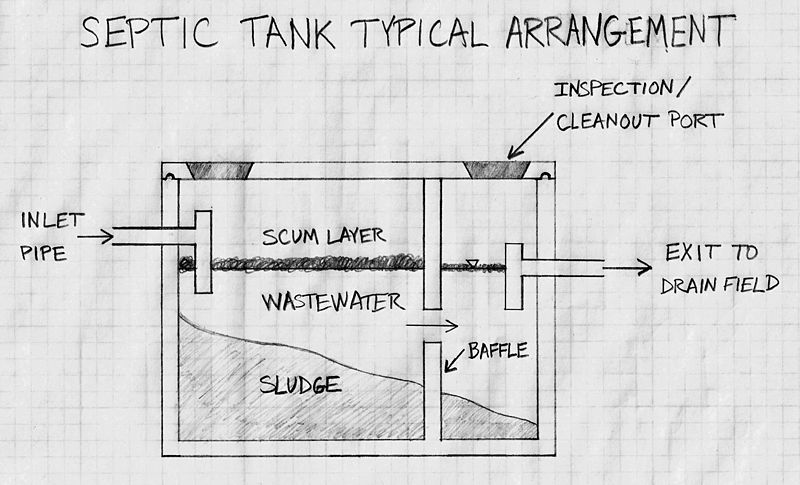How far is the leach field from the septic tank?
Are you planning to replace the old septic system with a new one? Or are you building your dream home and want to use a septic tank for the first time? Either way, it is important that you know the right distance between leach field and the septic tank, as well as between the leach field and your house and any surrounding well or stream.
So, how far is the leach field from the septic tank? Most experts recommend a minimum of 5 to 10 feet distance between the leach field and the septic tank. That said, a leach field can be immediately adjacent to the septic tank.
Call Septic Service Pros 855.925.0760 For Service or Request a Quote
How far is the leach field from the septic tank?
A septic tank works in tandem with a leach field or drain field. Most of the solid waste that flows with the wastewater from your house is broken down into liquid inside your septic tank, thanks to billions of bacteria and microbes residing in it. The sludge from your septic tank flows into the leach field, where it gets absorbed into the soil.
Since a leach field works hand in hand with a septic system, you can place it next to your septic tank, though experts usually recommend a distance of at least 5 to 10 feet between the two. Of course, you can place the leach field farther than 10 feet from your septic tank. Basically, the optimal distance between the leach field and the tank depends largely on your septic system’s layout, which in turn is usually dictated by the layout of the land on which the system is built.
How far the leach field should be from the house?
The leach field should be at least 10 feet from the house, at least 25 feet from dry gulches, and at least 100 feet from streams and wells. But keep in mind that these are basic guidelines and there are many variables involved. Much depends on things such as the design of the septic system, soil type, and terrain. And that is why the local regulations stipulating the minimum distance between the septic system and the house vary by location.
Call Septic Service Pros 855.925.0760 For Service or Request a Quote
How deep a leach field should be?
As said before, the leach or drain field is a crucial component of your septic system. If it is not sized properly, your septic system can throw up all kinds of problems, such as waste puddles forming in your backyard or lawn. Therefore, it is very important that you have a basic understanding of how a leach field functions. There is no need for you to turn into a septic expert; a little knowledge is all that you need and will help you maintain your leach field, and by extension your entire septic system, in top-notch condition.
Perforated pipes are laid down into a gravel field in a series to make a leach field. Usually, a completed bed has 12-14 inches of gravel below perforated pipes and another 2-3 inches over it. The leach field is next backfilled with 20 to 32 inches of soil in order to complete it and ensure that it is even with the ground surrounding it. As a result, most leach fields are roughly 3-4 feet deep.
All the same, sometimes a leach field might be a bit shallower. This in turn would mean that the pipes will run pretty close to the surface (6-7 inches). You may have to settle for a shallower leach field if there are underground obstacles, like high groundwater tables or a slab of bedrock under the soil.
In such situations, experts recommend that the leach field should be 12-24 inches over the underground obstacle. One of way achieving this is by making the leach field shallower but longer or wider. Sometimes, instead of this strategy, it is better to go for a raised or mounded drain field.
What can damage a septic tank drain field?
One of the most important components of a septic system, the septic drain field — also known as leach drains or leach fields — is where impurities and waste products that come out of the water released by the system are distributed into the soil. The drain field soil contains microbes and natural bacteria that break down the waste matter. However, if there are some problems with the drain field, this process may be hampered.
In case you notice any of these signs, that means there is some problem with the drain field.
- Sewage odors
- Soggy, spongy, or wet areas over the drain field or septic tank
- Presence of leafy, dark green, vegetation on the top of your drain field.
- Slow bathroom or kitchen drains
- Sewage backups or overflowing toilets
In most cases, drain field failures can be attributed to one or more the following 4 reasons:
- Oversaturation
- System age
- Crushing damage
- Blocked pipes
Generally, it is possible and economical to repair the drain field. However, if the septic system in question has reached the end of its lifespan, repairing the leach field, while possible, can be costly.
You might be wondering: “Is it possible to take steps to prevent drain field related issues from occurring?” The answer is yes. Here are some important to keep your drainfield in top condition, no matter what.
- Make sure the area around the drain field is free of grazing animals, heavy equipment, outbuildings, and boats
- Avoid planting vegetation or trees over the drain field
- Ensure downspouts drain away from your drain field.
- Schedule regular pumping of the septic tank (once every 2-5 years, depending on the size of your septic tank and usage)
- Do not flush medicines, sanitary napkins, an cat litter down the toilet; only flush toilet paper
- Do not overload your septic system by doing your entire week’s laundry in a single day












